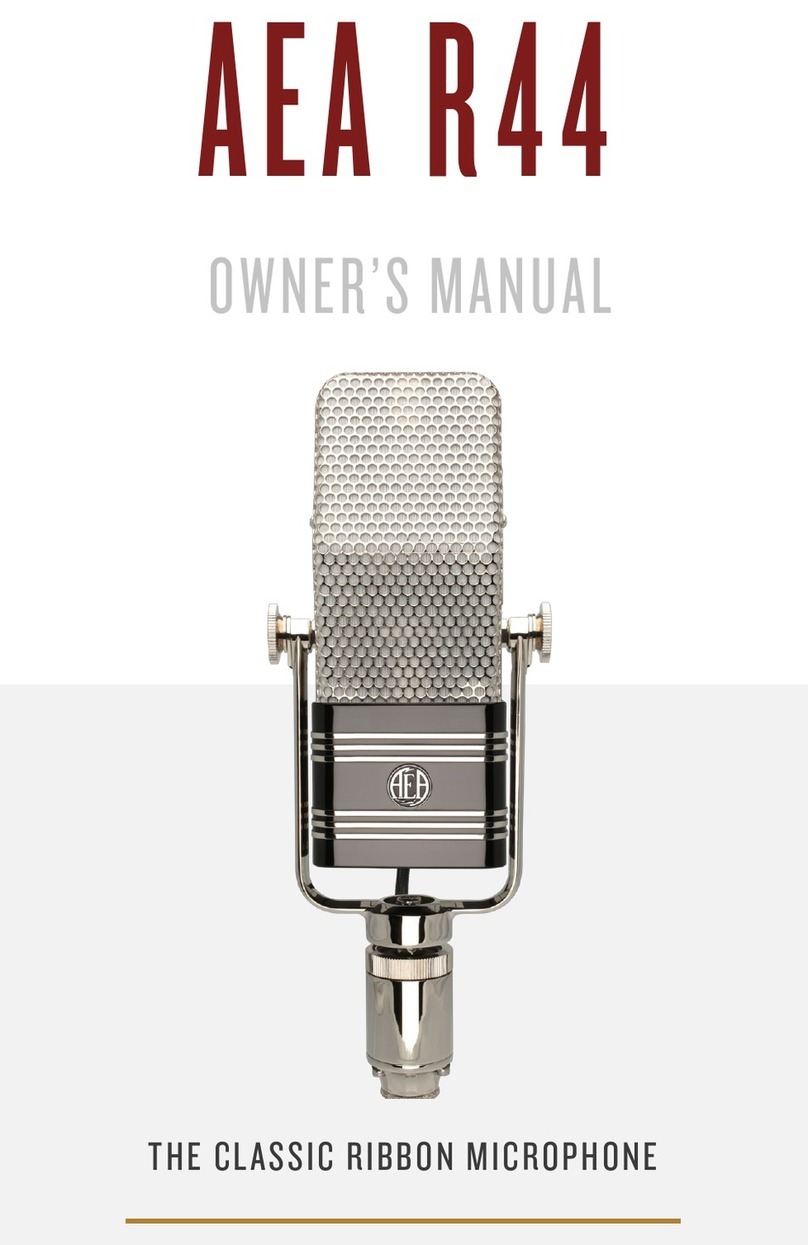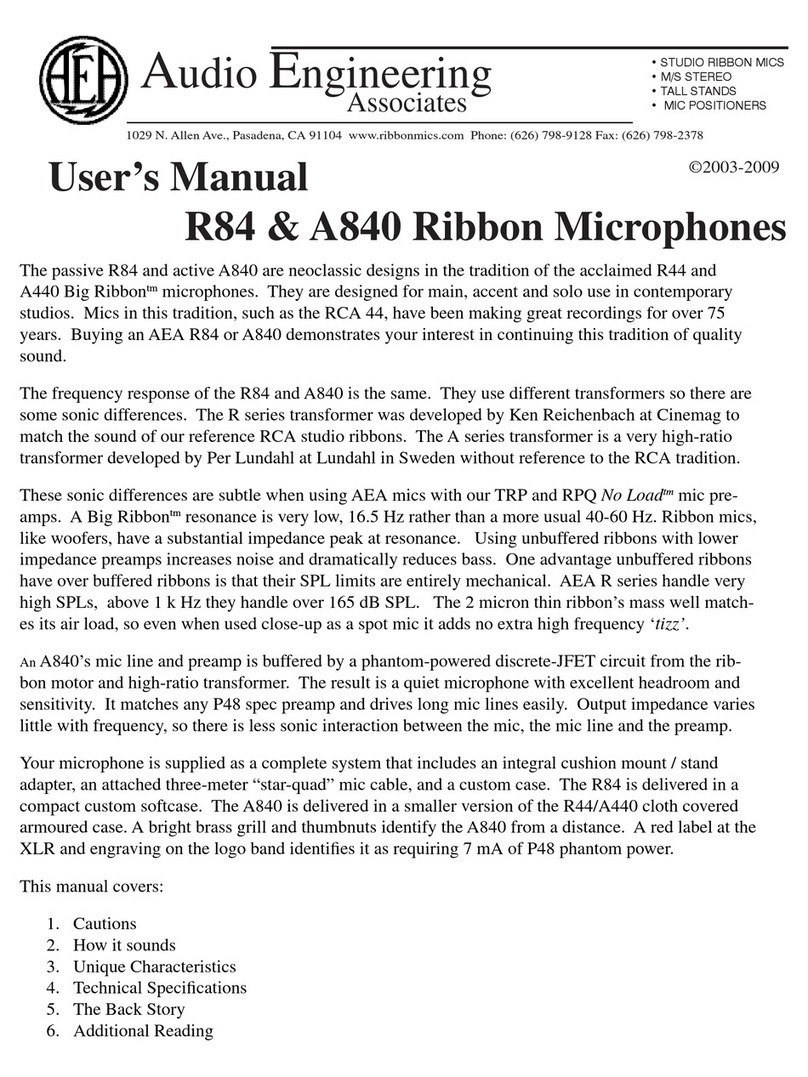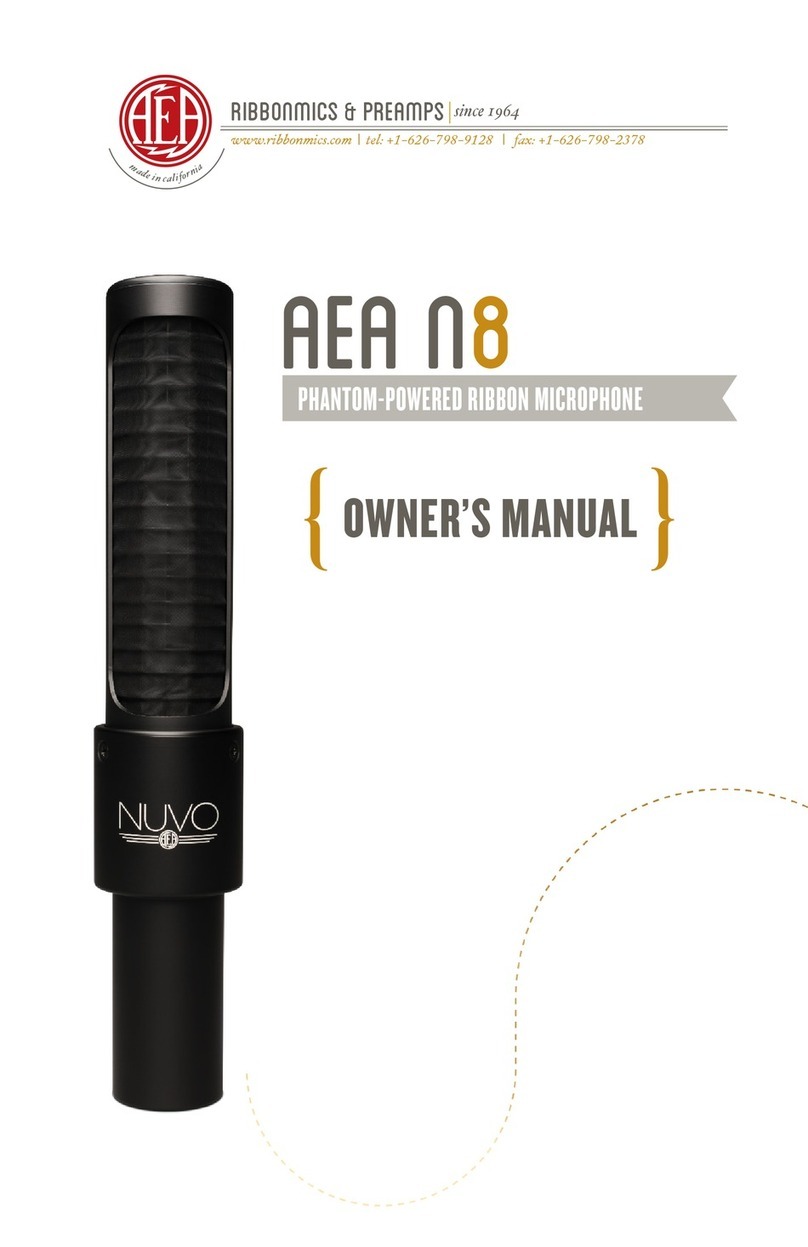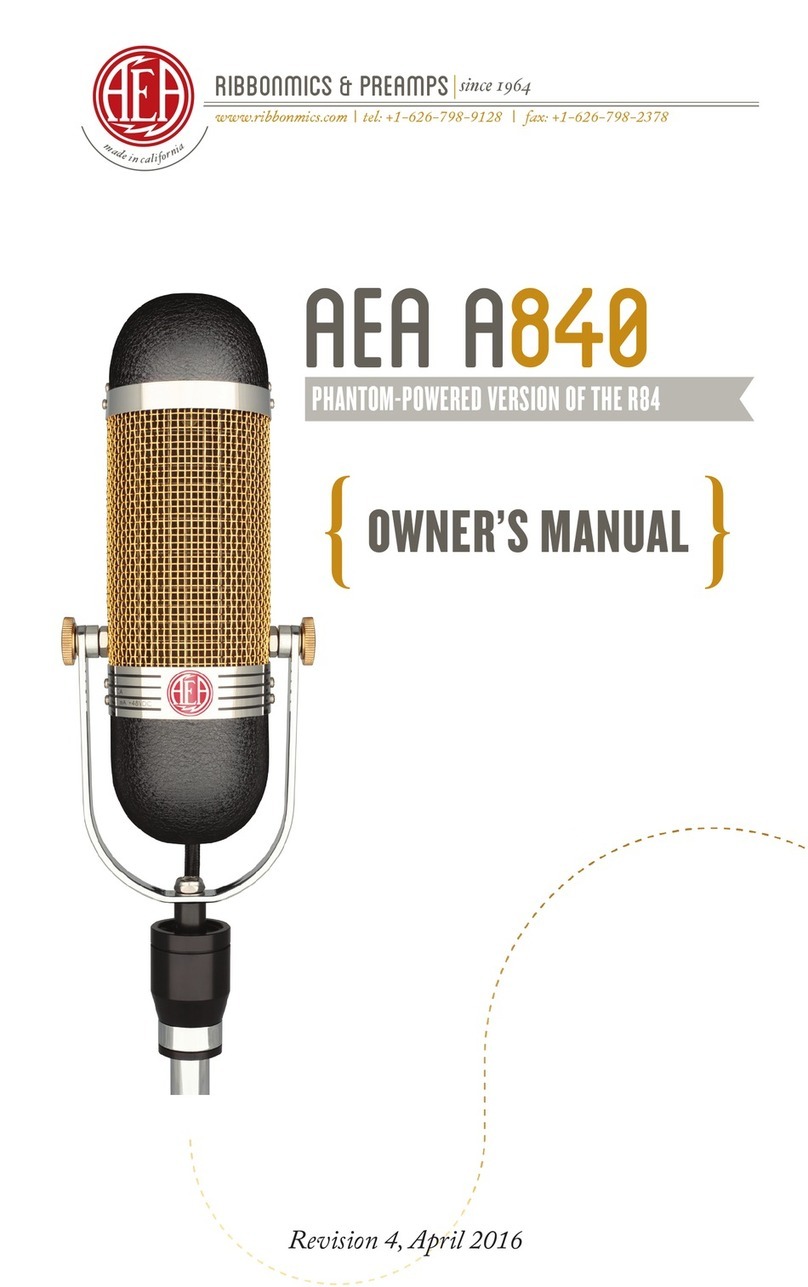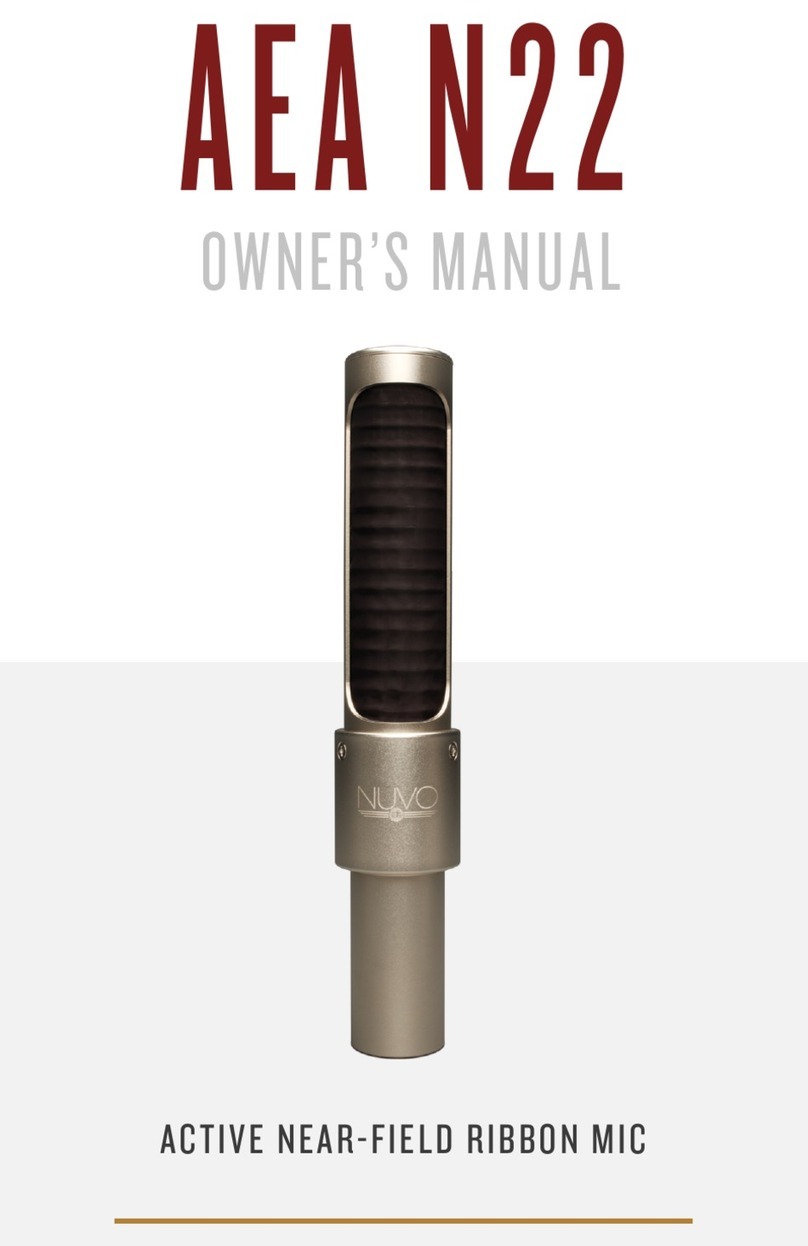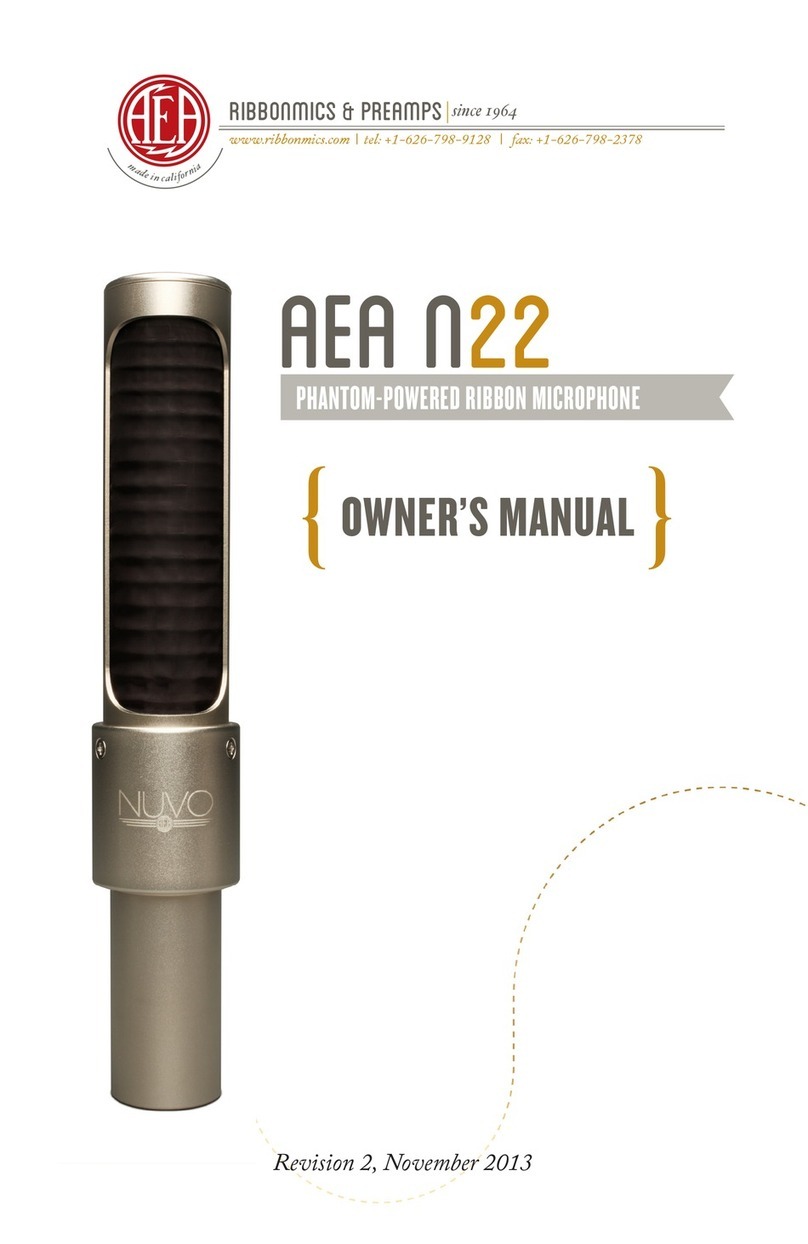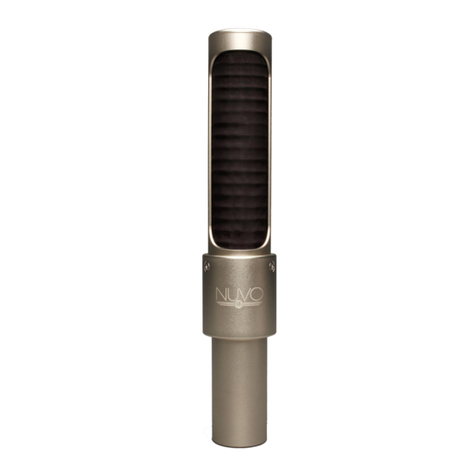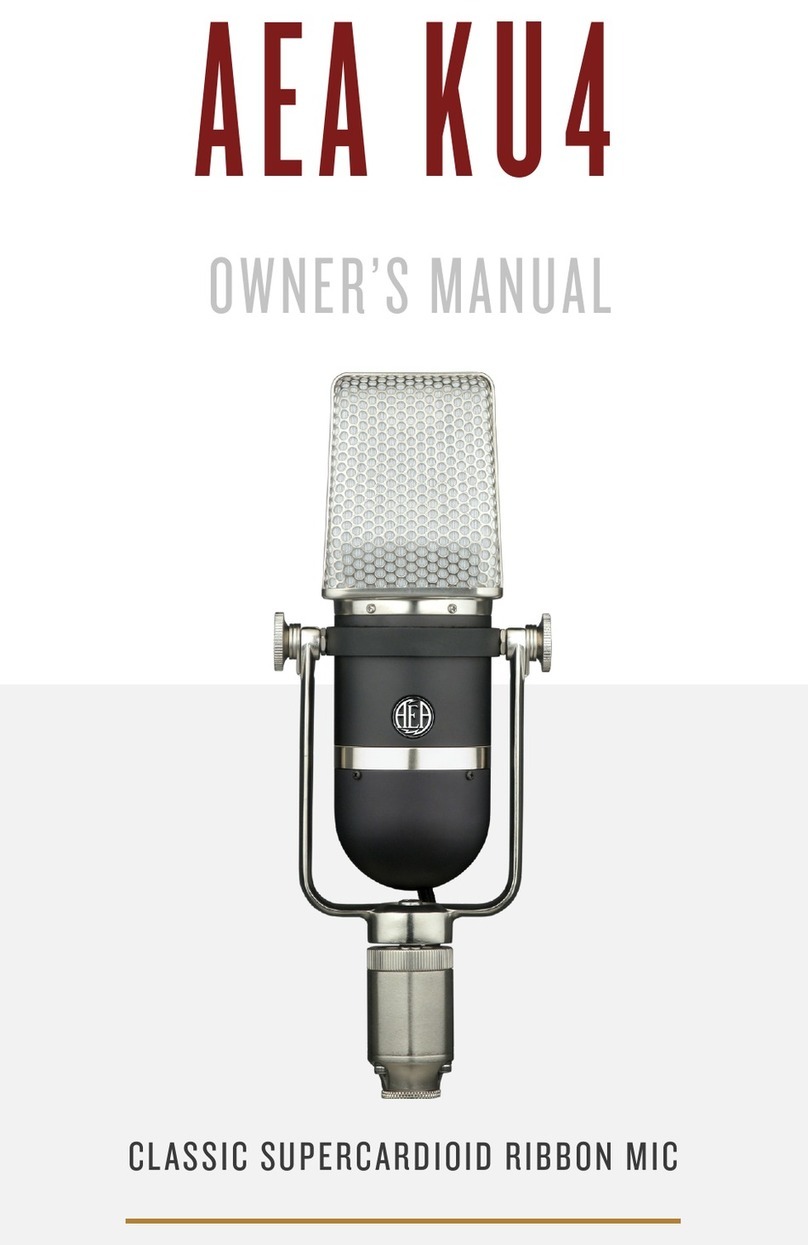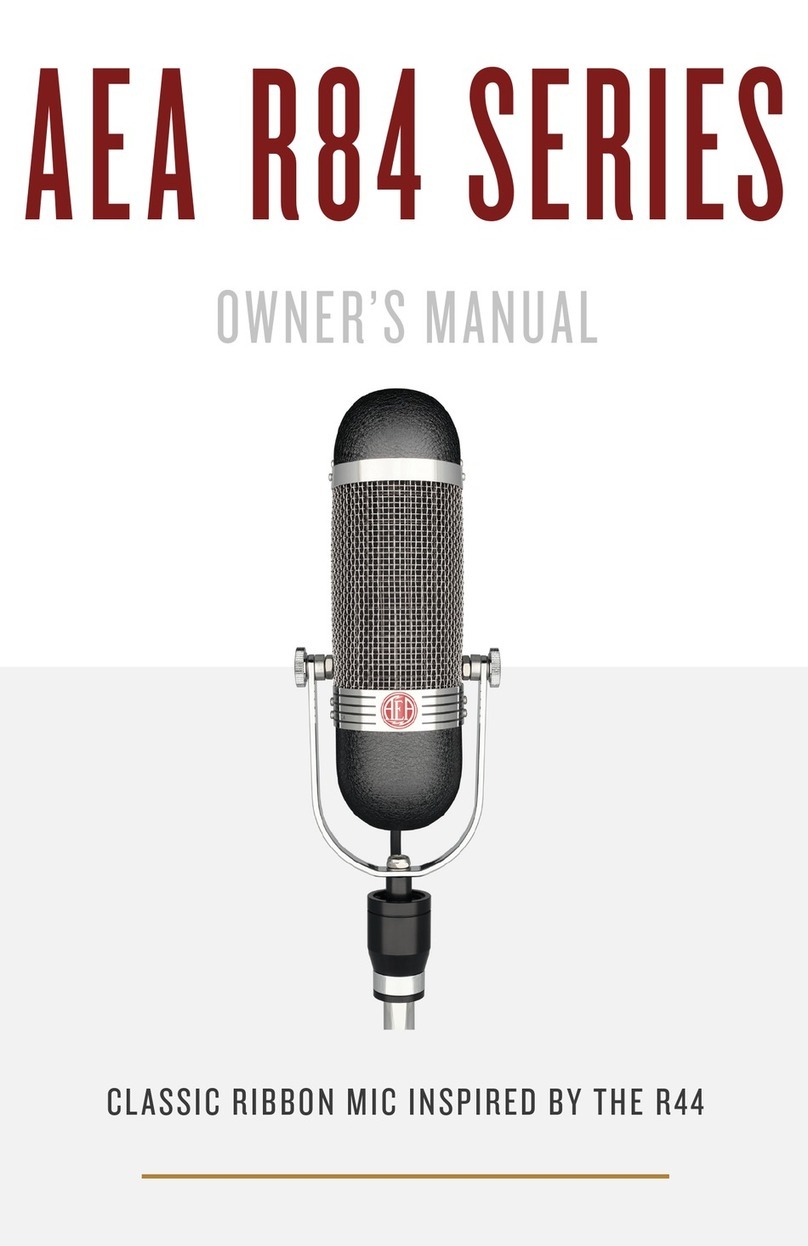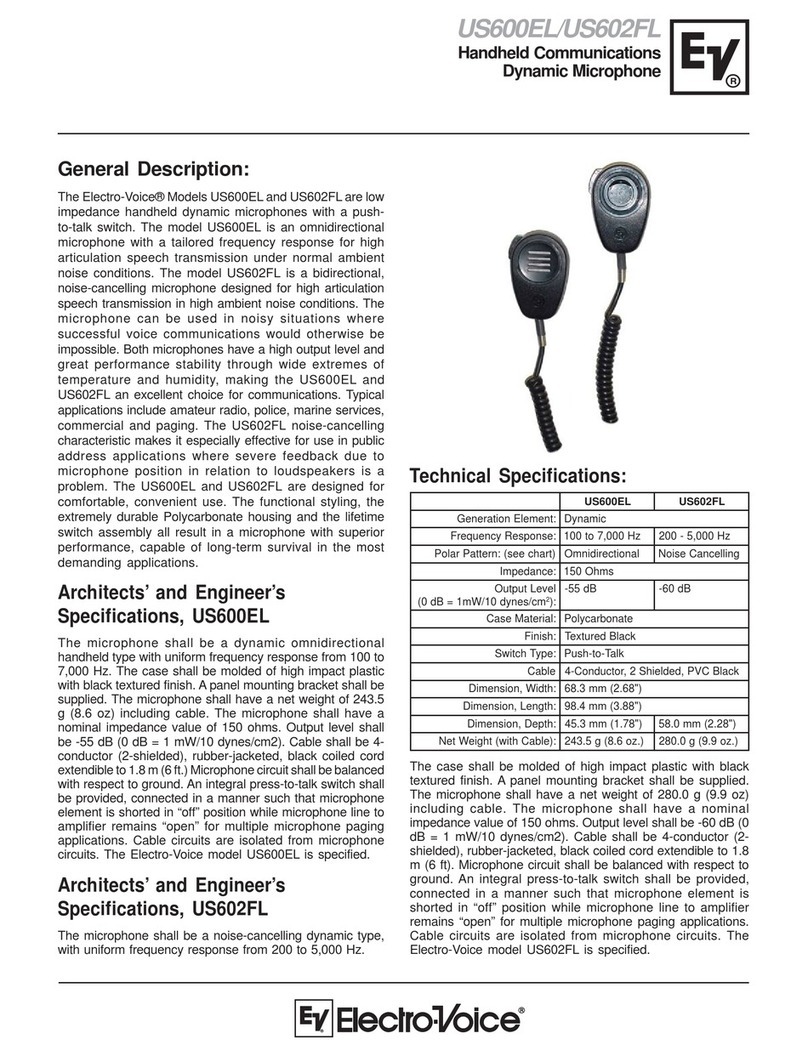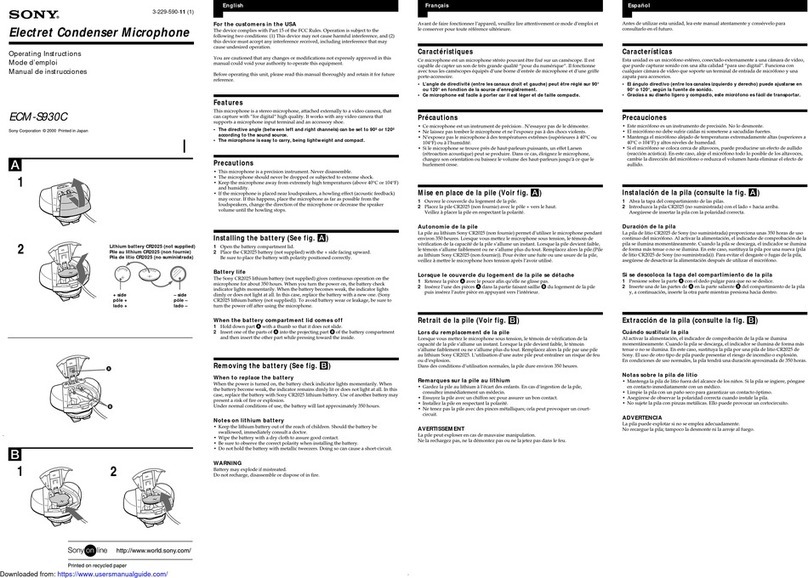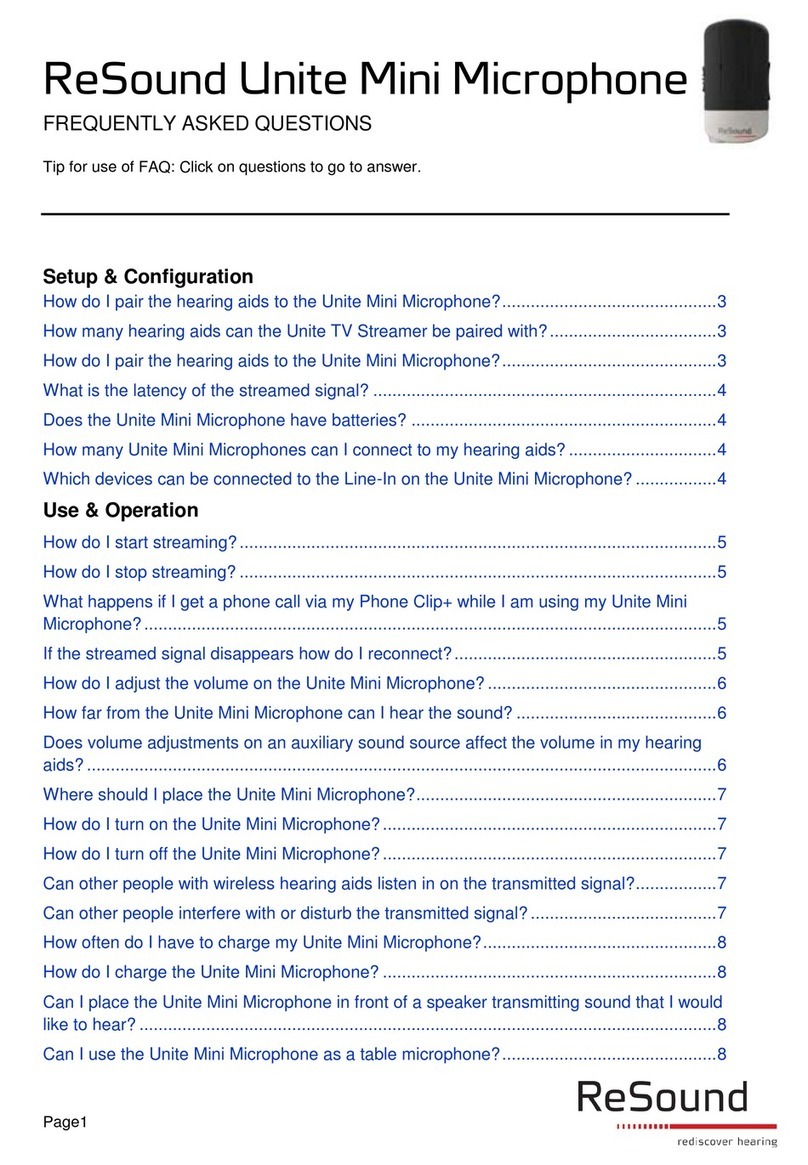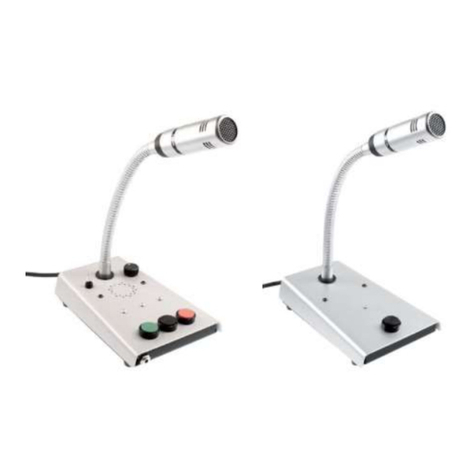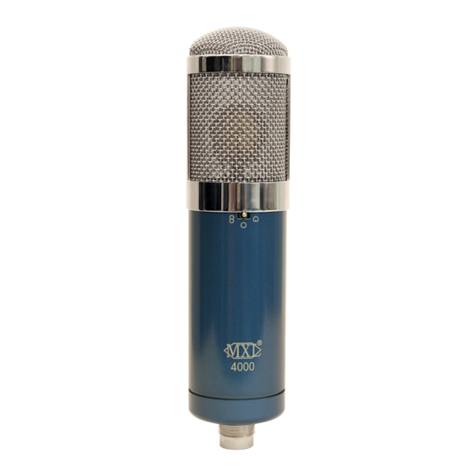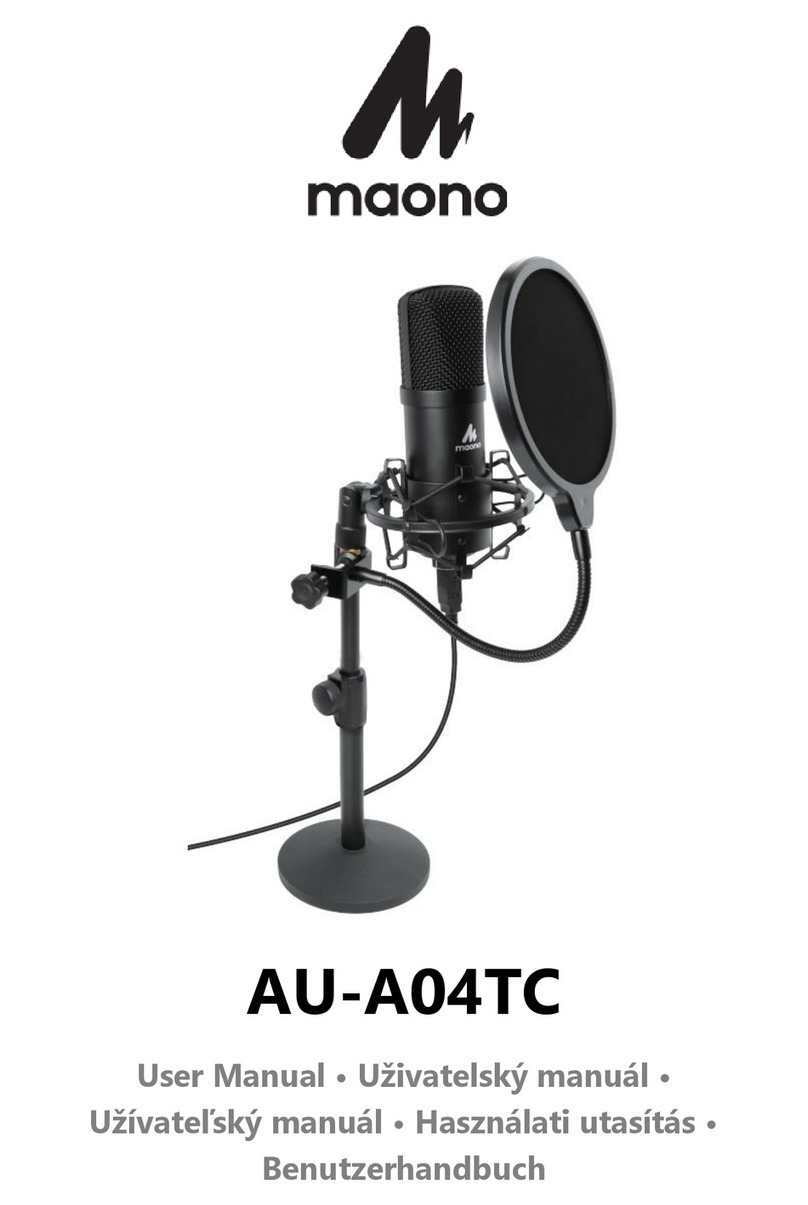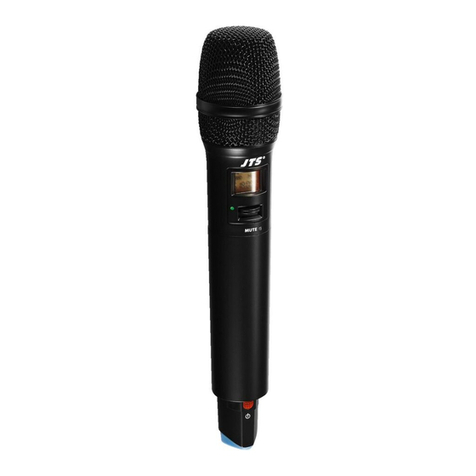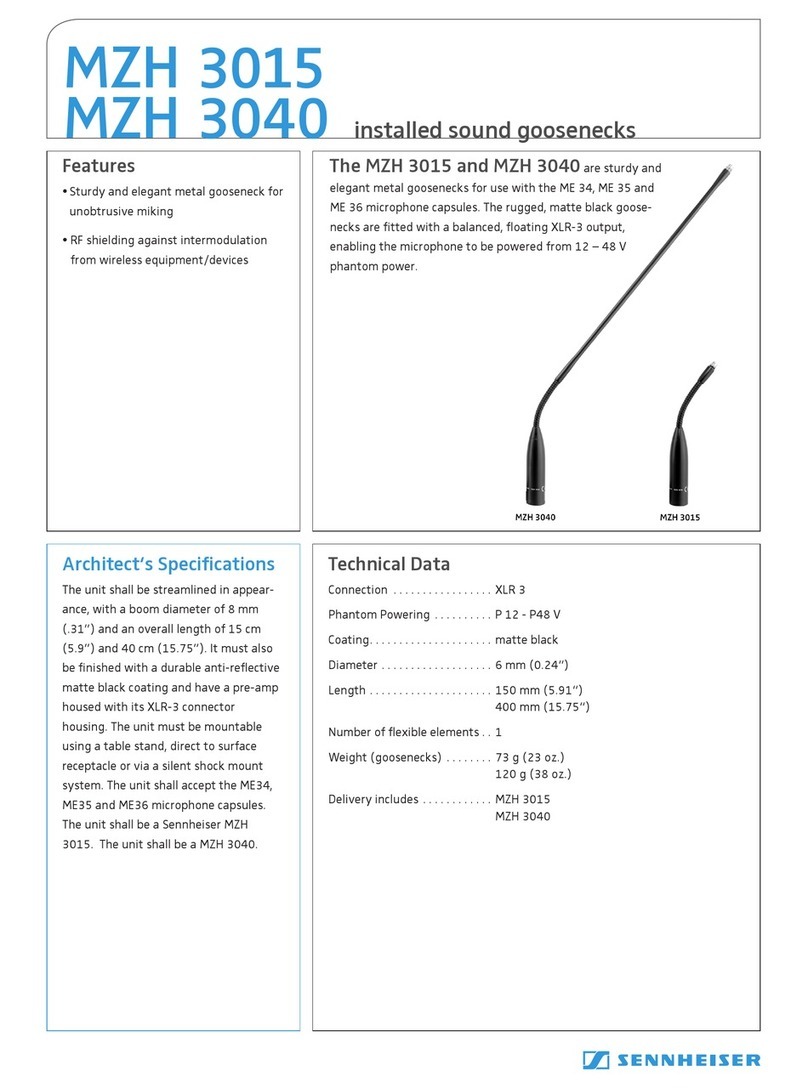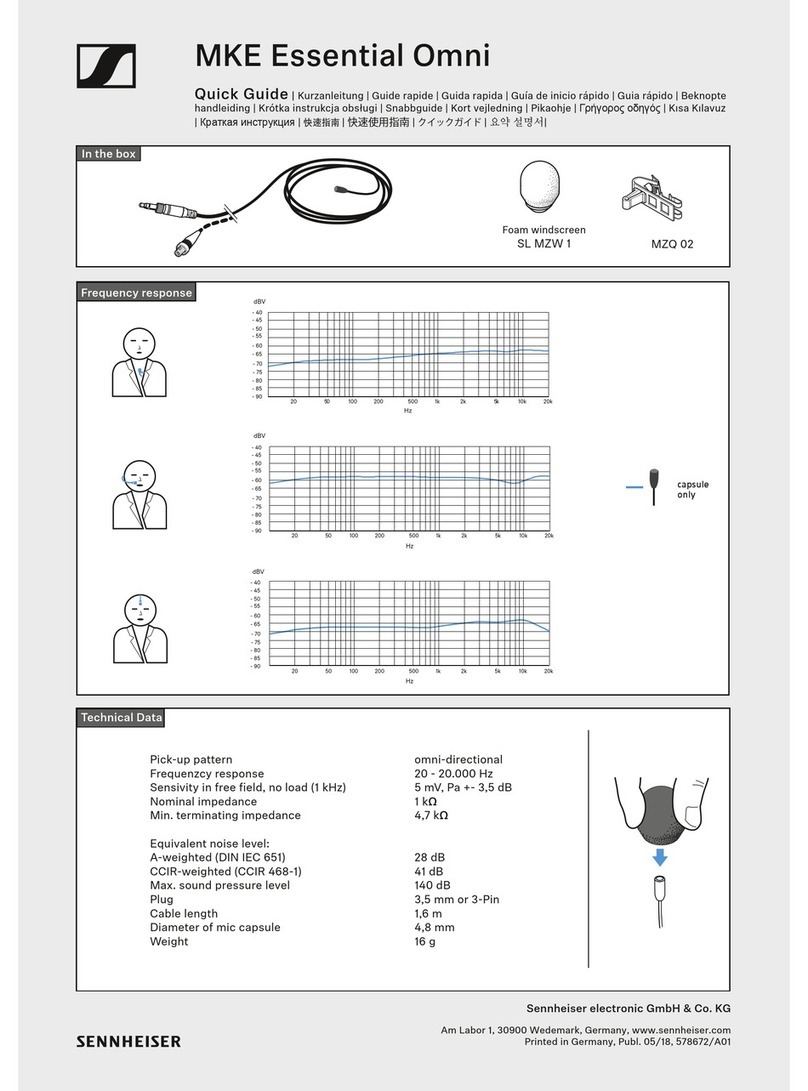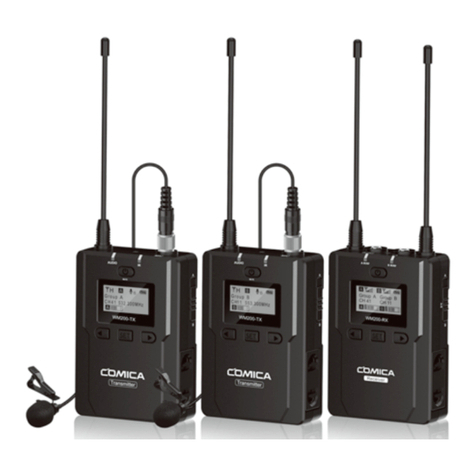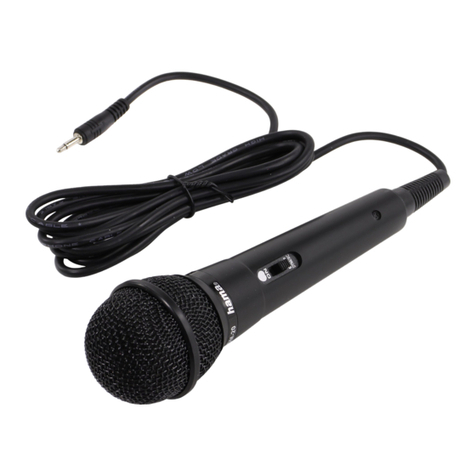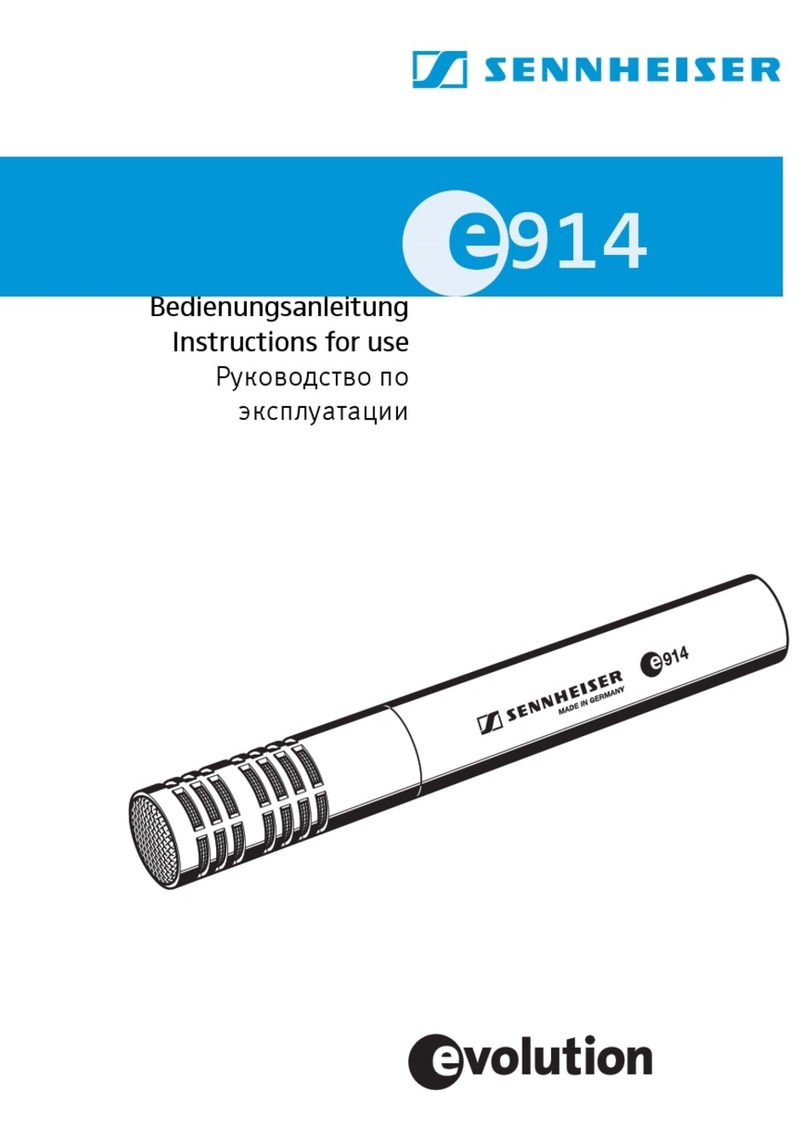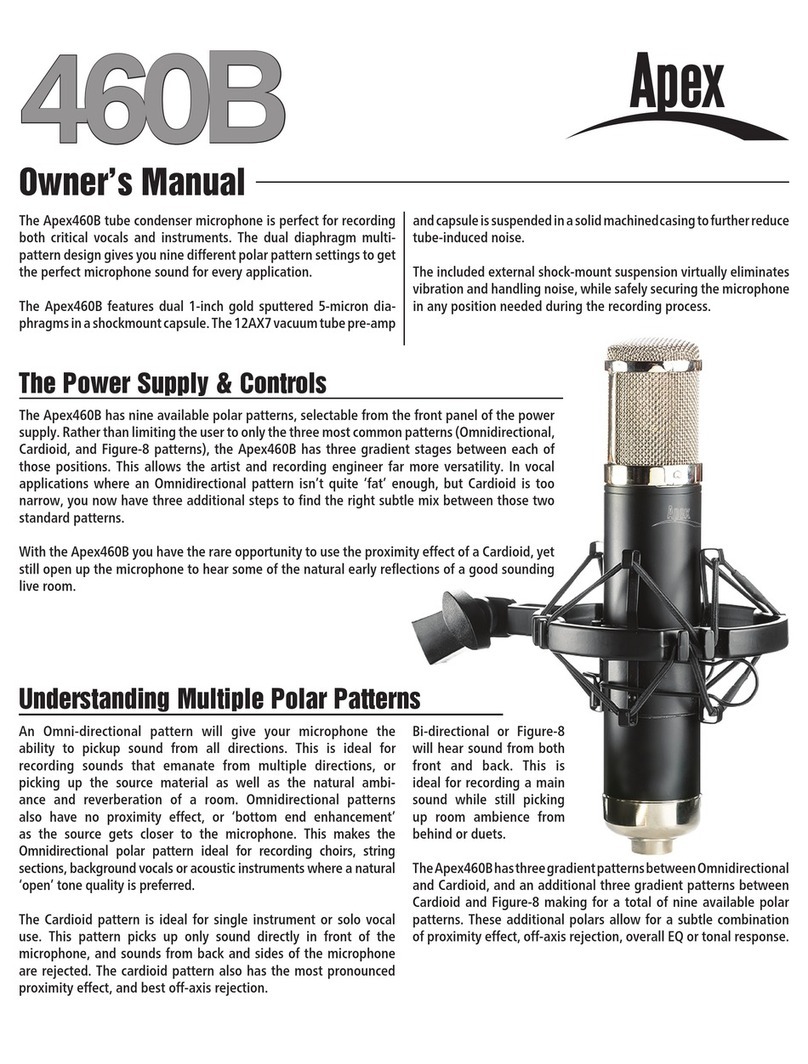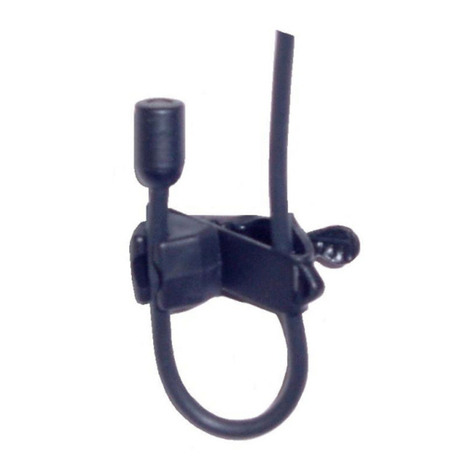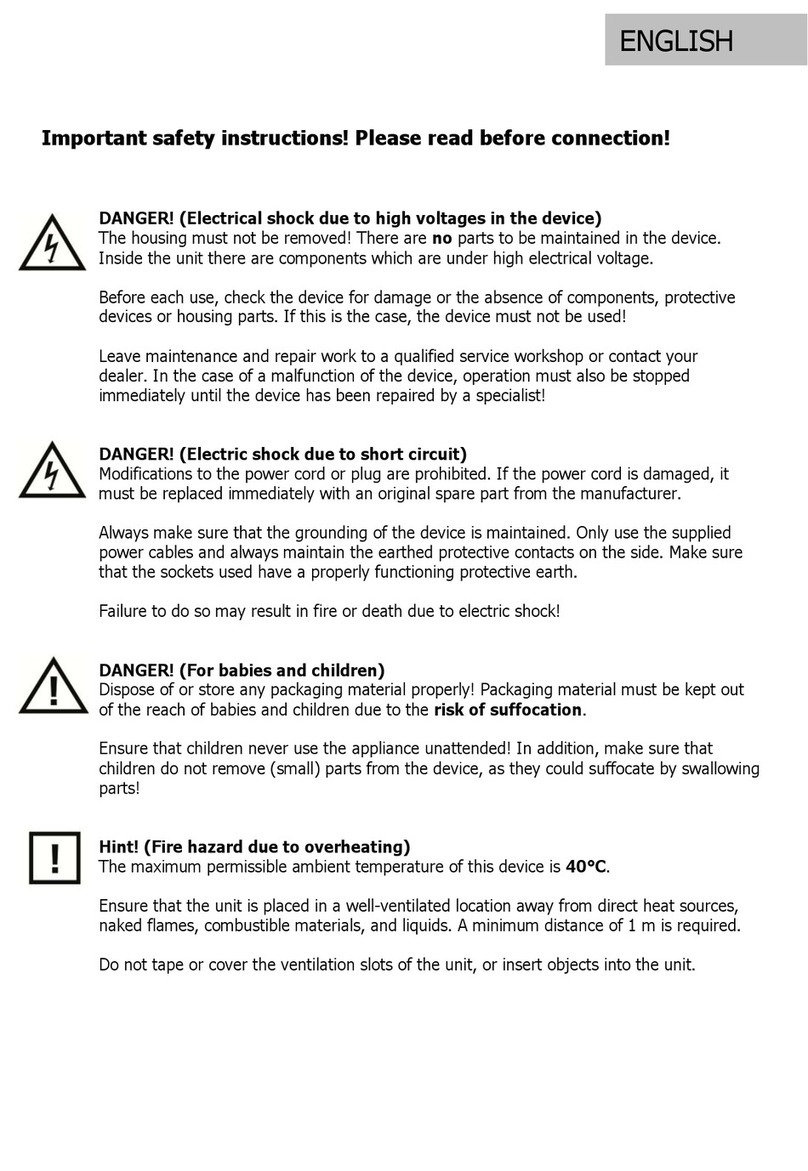AEA R92 User manual

OWNER’S MANUAL
CLASSIC PASSIVE RIBBON FOR UP-CLOSE
AEA R92

WELCOME
Congratulations on your purchase of the AEA R92 ribbon
microphone and welcome to the AEA family. AEA’s team of
engineers set out once again to expand the sonic possibilities of
ribbon microphones with the R92 model. We consider the R92
a near-field ribbon, delivering a bass-to-treble balance from up-
close. It's reduced proximity bass boost and excellent wind blast
protection make it suitable for close miking of guitar and bass
amps, drums and vocals. In addition, the integrated shock mount
and swivel allow for easy setup and positioning in tight spaces.
Utilizing the R92’s option of contrasting ‘crisp’ front and ‘traditional’
back lobe make the microphone a great tool to implement in the
studio and live.
Your R92 microphone is 100% handcrafted in Pasadena, CA. AEA
is a family owned company with a small crew of skilled technicians
– most of them being musicians themselves. Proudly independent,
we still manufacture all our ribbon microphones and preamps by
hand from locally sourced parts.
We hope your microphone will capture many magical performances
that touch the heart. This manual will help ensure that you get
the best sound and longevity from your new microphone. Please
become part of the AEA community by sharing your experiences
via e-mail, phone or social media.
Wes Dooley
President of AEA
2

CONTENTS
WELCOME
INTRODUCTION
SUPPORT
GENERAL GUIDELINES
APPLICATION ADVICE
SPECIFICATIONS
2
4
4
5
8
11
3

INTRODUCTION
The R92 is a pill-shaped, side-address, passive ribbon microphone
with a bidirectional (or figure-of-8) pickup pattern. It is assembled
with the same Big Ribbon™, tuning (16.5 Hz) and transformer as
the R44. Accommodating close and medium miking duties, the
R92 exhibits a flat frequency response when placed 6-12 inches
(15-30 cm) away from the source, capturing the classic body
and dimension of the Big Ribbon™ sound with reduced bass
proximity effect. As a result, the mic is well suited for electric guitar,
percussion, brass, vocals and drums. Its compact, lightweight
design and integrated 360º swivel mount allows for placement
versatility, while the custom shock mount suspension mitigates
undesired low frequency mechanical vibrations. What makes the
R92 truly unique is the contrasting tonal response on the front and
back lobes: the front side is defined by a “crisper” characteristic,
while the back side has a smooth, “traditional” top end roll-off.
WARRANTY
SUPPORT
Your R92 series mic comes with a one-year limited
warranty on parts and labor, shipping not included.
Registering your product with AEA will extend the
warranty to a full three years.
Register your microphone at AEAribbonmics.com.
If you should encounter any problems with your microphone or
have questions regarding using your R92 in specific application,
please contact our customer support team at support@ribbonmics.
com.
To talk to a live human being, call +1 (800) 798-9127, between 9:00
A.M.- 5:00 P.M. PT Monday through Friday. AEA's repair center is
located at 1029 N. Allen Ave, Pasadena, CA 91104, U.S.A.
4

GENERAL GUIDELINES
5
PHANTOM POWER
Your microphone is a valuable and important investment. Like any
piece of recording equipment or musical instrument, it requires
common sense and good basic care to keep it working properly.
Given simple, basic care, your new microphone will perform
admirably for decades.
Phantom power is not required or recommended for the passive
R92. We recommend avoiding the use of phantom power with your
R92 as a general rule. With a correctly wired cable and a properly
working phantom power supply, there is actually little danger of
damaging an R92 microphone with phantom power. However,
passive ribbons such as the R92 will get hurt if ground Pin 1 is
accidentally shorted, mis-wired, or hot patched in a patch bay to
Pin 2 or 3. Using phantom power with a faulty or mis-wired cable or
a defective supply can severely stretch or break a ribbon.
Since passive ribbon microphones or other transformer-coupled
microphones are particularly sensitive to phantom-power, it is
recommended to make disengaging phantom-power before
plugging and unplugging a habit.
PREAMPS FOR PASSIVE RIBBONS
Passive ribbon microphones generally have low output level and
require preamps that supply a high level of gain. If the preamp you
use does not have enough gain, the signal might seem too soft or
noisy.
The preamp input impedance affects the output level of the
mic in addition to the mic’s frequency and transient response
characteristics. It is generally recommended to use a preamp
that is at least 4 times the input impedance of the microphone’s
output impedance. However, a low or very high input impedance
on a preamp will not hurt a ribbon microphone. We recommend
clean, high impedance preamps with a minimum input impedance
of 1.2kΩ and at least 65dB of gain. To unleash the full potential
from your R92, AEA manufactures high-quality, high-gain, low-
noise preamps with a very high input impedance designed to

6
AIR TURBULENCE
Never expose the microphone to strong air turbulence. Ribbon
microphones can withstand very high SPL (Sound Pressure Level)
without difficulty, but can be damaged easily by a sudden, strong
gust of air or high levels of very low frequency sound waves (like
from a kick drum or bass cabinet). This can stretch the ribbon,
causing the microphone to start sounding flabby. Sources that
may produce strong blast of air, such as the bass port on an
electric guitar or bass amp, a guitar being plugged (or unplugged)
while the amp level is turned fully up, an on-axis kick-drum hole
(particularly with a port on the head), are potentially damaging.
To avoid possible damage, follow this simple procedure when
positioning the microphone called "The Hand Test": put the back
of your hand where the mic will be; if you can feel the motion of air
on your hand, place a pop-filter between the microphone and the
source of the wind gusts or simply pull the mic further back. When
recording kick drums or bass guitar cabinets, angle the microphone
to make sure that no wind blasts hit the microphone directly on-axis
from the front or back.
Keep the microphone covered when it is not in use. Keeping the
microphone covered when it is not in use will reduce the possibility
of damage that might result from a sudden gust of air coming from
air-conditioning or an open door or window. Place the supplied
protective bag over the microphone when it is not in use. For long
term storage, place the microphone in its protective case. Minute
iron particles, sometimes known as “tramp iron,” are common
within our environment. AEA ribbon microphones contain powerful
magnets that produce strong magnetic fields. These fields can
attract any ferric metal near the microphone that, if they are small
enough, can penetrate the outer screening and work their way
inside the microphone. Over time, this “tramp iron” can build up
sufficiently in the magnetic gap to rub against the ribbon causing
distortion, electrical shorts or tearing of the ribbon. The best
prevention is to keep the microphone covered with the supplied
plastic bag when it is not in use.
MICROPHONE STORAGE
bring out the full frequency response of ribbon microphones. Visit
AEARibbonmics.com to view our line of exceptional preamps.

MAGNETIC STRAY FIELDS
MICROPHONE POSITIONING
Always use a sturdy microphone stand. While the R92 was
designed to work well with all standard microphone stands, a high-
quality boom stand will make your life a little bit easier. The R92
was designed with placement versatility and vibration isolation in
mind. The microphone body is supported by a C-shaped yoke, and
is suspended using an elastic shock mount system. This structure
was designed to mitigate unwanted low frequency artifacts. To
obtain the shock mount benefits of the R92, we suggest adjusting
the swivel mount towards the source then positioning the angle of
the mic stand.
Ribbon microphones are fundamentally prone to picking up
strong external magnetic fields caused by light dimmers or nearby
power transformers. Guitar players will know this phenomenon
from single-coil pickups. Even though much attention was paid
to suppressing such sensitivity to external magnetic fields in
the design of your microphone, it is still possible that you might
encounter this problem. If you should pick up a hum, try rotating or
moving the microphone to find a spot where the hum disappears,
and try eliminating potential sources of stray magnetic fields. You
can use the microphone to find where hum is originating. Rotate
the mic for maximum interference and move it back and forth to
sense its direction.
The high-performance magnets used in AEA microphones are
incredibly strong, and a significant amount of stray magnetic field
lines surround the microphone. Avoid placing the microphone in
close proximity to hard drives, credit cards, analog tape, or any
other magnetically sensitive items to prevent any data loss.
7
Never blow directly into any microphone to test it. Not only
does this force moisture and dirt into the microphone, strong air
movement also can stretch the ribbon and while it may not break,
it nonetheless could significantly degrade the microphone’s
performance. The ribbon in the R92 is protected by multi-layered
screens and grille cloths to provide superior wind protection.
Nonetheless, using it outdoors requires special care to avoid wind
which can damage the ribbon. Indoors, however, it is also important
to avoid serious air movement from stage curtains, open windows,
doors, or air-conditioning systems.

DIFFERENT SIDES, DIFFERENT TONES
8
Figure-of-8 microphones are
constructed with positive
polarity on the front and
negative polarity on the
back. Positive pressure
on the front side of the
ribbon produces a
positive voltage on Pin-2,
with respect to Pin-3 on
the output connector.
Since the R92 is bidirectional, it exhibits nulls at right angles to the
principal axis. These nulls produce a “plane of rejection” around the
sides, top and bottom of the mic.
AEA intentionally designed the R92 to capture slightly different
frequency responses from the front and rear pickup lobes. The
front lobe of the R92 (denoted by the AEA emblem) is the “crisp”
side, offering exceptionally clean and realistic high end detail. The
rear lobe is the traditional “smooth” side, with the classic ribbon
extended roll-off of the highs, reminiscent of the iconic R44.
This gentle roll off helps handle harsh transients in a refined and
flattering way.
The R92’s dual characteristic provides two significant options for
your recording or live projects. If one side isn’t doing the trick, try
the other!
A FIGURE-OF-8 MICROPHONE
APPLICATIONS ADVICE
We actively encourage users to visit AEAribbonmics.com to
access our comprehensive collection of in-depth articles and
tutorials featuring the R92 microphone, along with a library of
audio and video demonstrations of the R92 in action.

HOW TO MINIMIZE BLEED
9
PROXIMITY EFFECT
A significant and ever-present challenge in contemporary
studio recording is minimizing “bleed” (also called “leakage” or
“crosstalk”) from nearby instruments into the various microphones.
The deep nulls of bidirectional ribbon microphones provide good
rejection of unwanted sounds, which also can be beneficial in
sound reinforcement situations where feedback is always a threat.
While gobos can be effective in isolating performers from each
other, they introduce their own set of problems, they usually are
bulky, they also inhibit the ability of the musicians to hear and see
each other easily.
Keep in mind that a certain degree of bleed is not necessarily
bad. For some styles and genres, it can, in fact, be beneficial to
embrace a little bit of bleed in order to create cohesive and natural
sounding recordings. Simply arrange the musicians so that nearby
instruments are placed in the “null” of their neighbor’s microphone,
and vice versa. Although this does not entirely eliminate the need
for gobos, it can significantly reduce how many you may need to
use. You will generally find that well-designed ribbon
microphones like the R92 capture a natural off-axis sound, which
means that bleed from other instruments can contribute to the
overall sound in a pleasing way.
Proximity effect
is a characteristic
of all directional
microphones; it is a
rise in low-frequency
response that
increases at closer
working distances.
While this can be
used to good effect,
particularly with male
voices to give them
an enhanced richness and depth, the potential trade-off is reduced
articulation or clarity that can result from the masking effect on the
treble due to “excessive” bass boost.

10
We consider the R92 a near-field ribbon microphone which means
the R92 was designed to shine on close miking applications.
However, as a figure-of-8 microphone, it intrinsically exhibits
proximity effect. Compared to the R44, which achieves proximity
effect from six feet away, the proximity effect from the R92 is
substantially less and exhibits a flat frequency response when
placed at a distance of 6-12 inches (15-30 cm) from the source.
FREQUENCY RESPONSE

11
SPECIFICATIONS
Storage/shipping case, user manual, captive 10” (3 meter) output cable with
XLR-3M connector.
Accessories Included
Operating Principle:
Directional Pattern:
Frequency Range:
Maximum SPL:
Sensitivity:
Output Impedance:
Recommended Load
Impedance:
Phantom Power:
Polarity:
Polar Response:
Horizontal:
Vertical:
Transducer Element Material:
Thickness:
Width:
Length:
Microphone Dimensions:
Height:
Width:
Depth:
Weight:
Shipping Weight:
Connector:
Pressure gradient transducer
Bidirectional
<20 Hz to >20 kHz
165+ dB SPL (1% third harmonic > 1 kHz)
1.8 mV/Pa (-55 dBV) into unloaded circuit
270 Ω Broadband
1.2k Ω or greater
Not required or recommended.
Pin 2 high for positive pressure at the
front of the microphone.
Native bidirectional, gure-of-8 pattern.
Up to 90 dB rejection at right angles to the
front/back axis.
Level changes with angle of incidence, but
frequency response is consistent.
Pure aluminum corrugated ribbon
1.8 µm
0.185 in (4.7 mm)
2.35 in (59.7 mm)
7.5 in (19.1 cm)2.9 in (7.4 cm)
2.5 in (6.4 cm)
1.97 lb (893 g)
2 lbs (0.9 kg)
2 lbs (0.9 kg)
XLR-3M

Table of contents
Other AEA Microphone manuals
